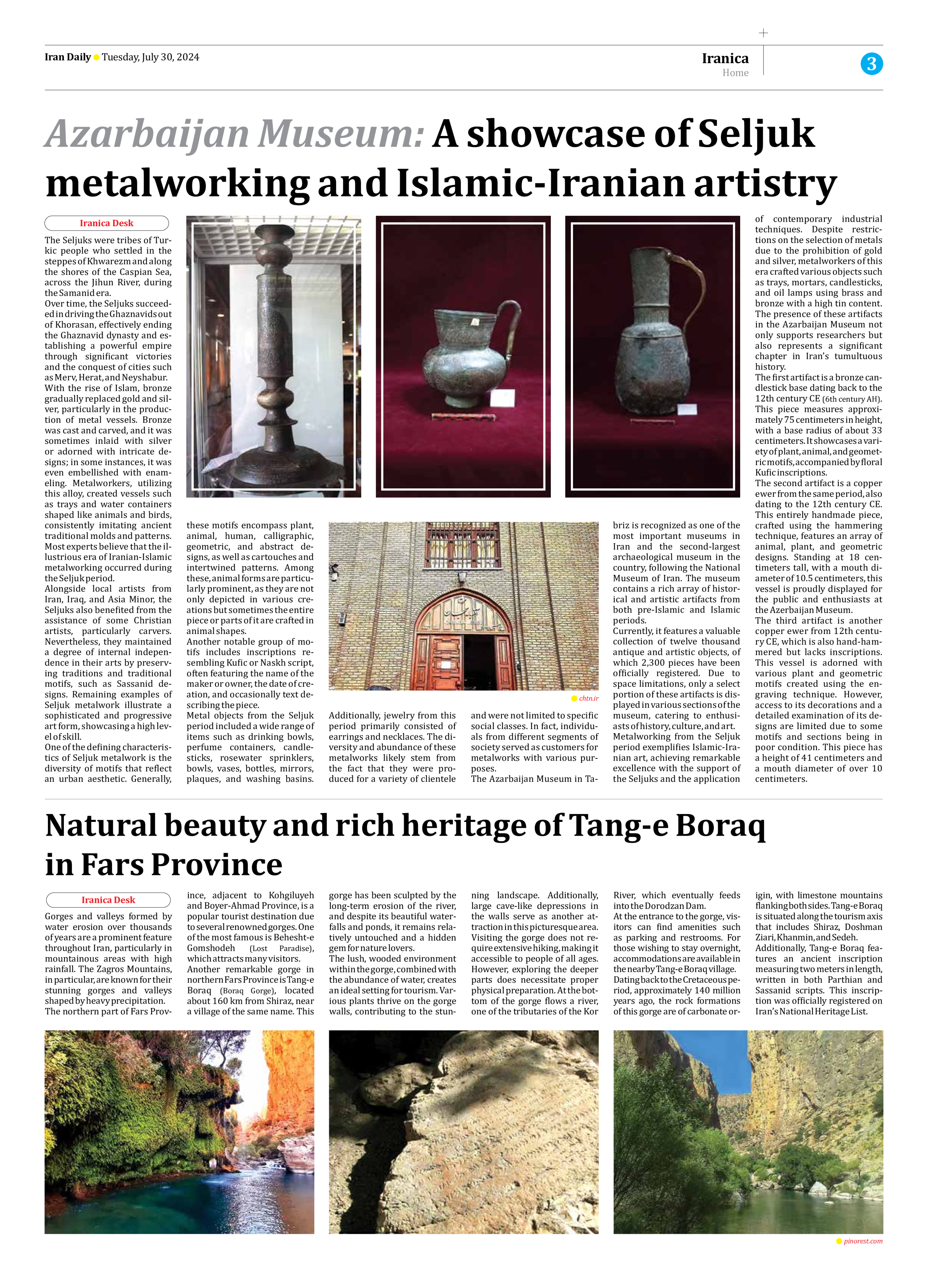
Azarbaijan Museum: A showcase of Seljuk metalworking and Islamic-Iranian artistry
The Seljuks were tribes of Turkic people who settled in the steppes of Khwarezm and along the shores of the Caspian Sea, across the Jihun River, during the Samanid era.
Over time, the Seljuks succeeded in driving the Ghaznavids out of Khorasan, effectively ending the Ghaznavid dynasty and establishing a powerful empire through significant victories and the conquest of cities such as Merv, Herat, and Neyshabur.
With the rise of Islam, bronze gradually replaced gold and silver, particularly in the production of metal vessels. Bronze was cast and carved, and it was sometimes inlaid with silver or adorned with intricate designs; in some instances, it was even embellished with enameling. Metalworkers, utilizing this alloy, created vessels such as trays and water containers shaped like animals and birds, consistently imitating ancient traditional molds and patterns. Most experts believe that the illustrious era of Iranian-Islamic metalworking occurred during the Seljuk period.
Alongside local artists from Iran, Iraq, and Asia Minor, the Seljuks also benefited from the assistance of some Christian artists, particularly carvers. Nevertheless, they maintained a degree of internal independence in their arts by preserving traditions and traditional motifs, such as Sassanid designs. Remaining examples of Seljuk metalwork illustrate a sophisticated and progressive art form, showcasing a high level of skill.
One of the defining characteristics of Seljuk metalwork is the diversity of motifs that reflect an urban aesthetic. Generally, these motifs encompass plant, animal, human, calligraphic, geometric, and abstract designs, as well as cartouches and intertwined patterns. Among these, animal forms are particularly prominent, as they are not only depicted in various creations but sometimes the entire piece or parts of it are crafted in animal shapes.
Another notable group of motifs includes inscriptions resembling Kufic or Naskh script, often featuring the name of the maker or owner, the date of creation, and occasionally text describing the piece.
Metal objects from the Seljuk period included a wide range of items such as drinking bowls, perfume containers, candlesticks, rosewater sprinklers, bowls, vases, bottles, mirrors, plaques, and washing basins. Additionally, jewelry from this period primarily consisted of earrings and necklaces. The diversity and abundance of these metalworks likely stem from the fact that they were produced for a variety of clientele and were not limited to specific social classes. In fact, individuals from different segments of society served as customers for metalworks with various purposes.
The Azarbaijan Museum in Tabriz is recognized as one of the most important museums in Iran and the second-largest archaeological museum in the country, following the National Museum of Iran. The museum contains a rich array of historical and artistic artifacts from both pre-Islamic and Islamic periods.
Currently, it features a valuable collection of twelve thousand antique and artistic objects, of which 2,300 pieces have been officially registered. Due to space limitations, only a select portion of these artifacts is displayed in various sections of the museum, catering to enthusiasts of history, culture, and art.
Metalworking from the Seljuk period exemplifies Islamic-Iranian art, achieving remarkable excellence with the support of the Seljuks and the application of contemporary industrial techniques. Despite restrictions on the selection of metals due to the prohibition of gold and silver, metalworkers of this era crafted various objects such as trays, mortars, candlesticks, and oil lamps using brass and bronze with a high tin content. The presence of these artifacts in the Azarbaijan Museum not only supports researchers but also represents a significant chapter in Iran’s tumultuous history.
The first artifact is a bronze candlestick base dating back to the 12th century CE (6th century AH). This piece measures approximately 75 centimeters in height, with a base radius of about 33 centimeters. It showcases a variety of plant, animal, and geometric motifs, accompanied by floral Kufic inscriptions.
The second artifact is a copper ewer from the same period, also dating to the 12th century CE. This entirely handmade piece, crafted using the hammering technique, features an array of animal, plant, and geometric designs. Standing at 18 centimeters tall, with a mouth diameter of 10.5 centimeters, this vessel is proudly displayed for the public and enthusiasts at the Azerbaijan Museum.
The third artifact is another copper ewer from 12th century CE, which is also hand-hammered but lacks inscriptions. This vessel is adorned with various plant and geometric motifs created using the engraving technique. However, access to its decorations and a detailed examination of its designs are limited due to some motifs and sections being in poor condition. This piece has a height of 41 centimeters and a mouth diameter of over 10 centimeters.







